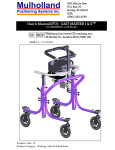Download User`s Manual User`s Manual
Transcript
Stots Corporations simple to use TemplateMaster TM Users Manual Version 1.01 Feel the satisfaction of making beautiful, precisely fitted Dovetails. . . benchmark of excellence in woodworking. TM U.S. PATENTS: 5,692,861, 6,012,497 www.stots.com In 1995 being a frustrated woodworker that could not buy a good inexpensive dovetail jig, I decided to build my own. I quickly found out it was impossible to machine an accurate template in my wood shop. I figured that if I experienced this problem others would also. Therefore I set out on a quest to solve this terrible problem. This quest evolved into the Dovetail Template MasterTM. I hope you enjoy making dovetails with your working jigs as much as I do. It is a great relief not to worry about damaging a very expensive jig each time I make a cut (by the way, its not if you cut your jig but rather w h e n you will cut your jig). The freedom to machine any spacing or length template and to make dedicated jigs with scrap wood from my shop is fantastic. It makes woodworking more fun! My wifes eyes sparkle when she sees my projects with dovetails now. She knows dovetails are the benchmark of skill in woodworking. Friends marvel at the joints. They are convinced that it takes years of practice and great talent to produce. I dont tell them how really easy dovetails are to make now. Why should I? If you send me a letter telling about your unique applications for the Template MasterTM or any problems you experienced, I can improve the tool and directions for all woodworkers. You can also e-mail me at [email protected]. My internet site stores information about other products, updates to the instructions, and more good stuff. Check out the Honor Statement on the inside back cover for a very valuable benefit to registering your tool. Enjoy your Dovetail Template MasterTM and please tell a friend. Richard L. Stottmann P.S. My lawyers, with good reason, insist on the following: Copyright Stots Corporation 1997, 2003. All rights reserved. Trademarks are owned by Stots Corporation. PO Box 257 Harrods Creek KY 40027 Very important stuff Anatomy of a Dovetail Joint Pin Board Tail Socket Pin Dovetail Pin Socket Half Pin Anatomy of a Working Template Tail side opening Tail Board Working template Triangle 1/4 inch alignment line Pin side opening 1 Where to find it Fir st things ffir ir st . . . . . . . . . . . . . . . . . . . . . . . . . . . . . . . . . . Page 4 irst irst w to mak or king jigs – Method 1 and Method 2 . . . . . . . Page 6 Ho How makee w wor orking Test cut and ho w to use w or king jigs . . . . . . . . . . . . . . . . . . Pa ge 10 how wor orking Ho w to adjust w or king jigs . . . . . . . . . . . . . . . . . . . . . . . . . Page 14 How wor orking 2 Where to find it Ho w to mak lind do How makee half b blind dovvetails . . . . . . . . . . . . . . . . . . . . . . . . . . . Pa ge 16 Ho w to mak How makee angled do dovvetails . . . . . . . . . . . . . . . . . . . . . . . . . . . . . Pa ge 18 Ho w to mak x joints . . . . . . . . . . . . . . . . . . . . . . . . . . . . . . . . . Pa ge 20 How makee bo box Ho w to mak How makee hing hingee joints . . . . . . . . . . . . . . . . . . . . . . . . . . . . . . . . Pa ge 23 Troub leshooting . . . . . . . . . . . . . . . . . . . . . . . . . . . . . . . . . . . . . . . oubleshooting ety Rules ffor or Tools . . . . . . . . . . . . . . . . . . . . . . . . . . . . . . . . . . . . Safety Saf License Ag Agrreement . . . . . . . . . . . . . . . . . . . . . . . . . . . . . . . . . . . . . Honor Statement . . . . . . . . . . . . . . . . . . . . . . . . . . . . . . . . . . . . . . Pa ge 24 Pa ge 26 Pa ge 28 Pa ge 29 3 First things first Safety: THINK! Think about what you are doing before you do it. If it does not feel right ... DONT DO IT! Read the Safety Chapter for important safety instructions F ir st things ffir ir st. irst irst. Which spacing working template should you make 1 inch or 2 inch? The best answer is to make both! The Make-It-Right TM Dovetail Template Master TM is so simple to use, don’t compromise. Make and use both template spacings. It hardly costs anything to make a second working template. As a matter of fact it makes sense to make dedicated jigs for your projects. 4 Mater ials rrequir equir ed to mak our Materials equired makee yyour w or king do orking dovv etail and pin jigs. (A) Working template blanks should be 7 1/2 inches wide by 10 1/2 inches long. Recommended materials are: (a) 3/4 inch to 1/2 inch solid wood (b) 3/4 inch to 1/2 inch veneer plywood also called Russian, European,Applewood, or shop grade plywood, or (c) 3/4 inch to 1/2 inch MDF (medium density fiberboard). NOTE: 3/4 inch thick blank material is required if you want to dovetail boards less than 3/4 inches thick. (B) The backer board should be 2 1/4 inch wide by 3 1/2 inch tall; and 6 inches longer than the combined length of the working templates to be machined. Recommended materials are: (a) solid wood, or (b) glue together (to make a board 2 1/4 inches thick) three pieces of the 3/4 inch thick working template material used. The tools rrequir equir ed to mak equired makee and use your do or king jigs ar e: dovvetail w wor orking are: (A) Router with 1/4 inch collet; (B) 8 degree Dovetail bit 1/2 inch diameter, 13/16 inch cutter length, and 1/4 inch shaft with either a 5/8 inch ball bearing guide or 5/8 inch router guide; (C) 1/2 inch diameter by 3/4 inch minimum length pattern bit with 1/4 inch shaft and 1/2 inch ball bearing guide; (D) Screw driver; (E) Drill; (F) #10 1 1/2 inch counter sink drill bit; (G) drill bits: 1/4 inch diameter and 3/4 and 5/8 inch diameters (forstner recommended); First things first (H) reciprocating saw or chisel; (I) .5mm drafting pencil or sharp scratch awl. Har d war equir ed: Hard aree rrequir equired: (1) you will need two 3/4 inch #10 pan head screws to secure the Make-It-Right TM Dovetail Template Master TM to the working template blank for routing; (2) you will need two 1/2 inch diameter flat washers to secure the Make-It-Right TM Dovetail Template Master TM to the working template blank for routing; (3) for each working template you will need two 1/2 inch diameter flat washers to position each of your working templates on your backer board before adjustments are completed; (4) for each working template you will need two 1 1/2 inch #10 flat head screws to “lock” each of your working templates to backer board after adjustments are completed. An additional rrouter outer bit is r equir ed to mak x joint and equired makee bo box hing hingee joint jig: A 1/2 diameter 13/16 inch minimum length straight cutter with a 5/8 inch diameter bearing is required to cut both the box joint and hinge joint. The additional har d w ar hard aree ed to mak x joint and r equir equired makee bo box hing hingee joint jig jig:: (1) two 3/4 inch #10 pan head screws to secure positioning stop; (2) two 1/2 inch diameter flat washers to secure your positioning stop before adjustments are completed; (3) two 1 1/2 inch #10 or #12 flat head screws to “lock” your positioning stop. NOTE: The ball bearing guide is a must for the pattern bit. It is the only way to accurately machine your working templates using the Make-It-Right TM Template Master TM. A router guide can be used with the dovetail bit and the box joint cutter. However, I very highly recommend a 5/8 inch diameter ball bearing guide for both the dovetail cutter and the box joint straight cutter because the concentricity and accuracy of the ball bearing guide is better than guides. 5 How to make working jigs Method 1 ove 3 inc rha h ng Screw the Make-It-RightTM Dovetail Template Master TM to 1/2 to 3/4 inch thick by 7 1/2 inch wide and 10 1/2 inch long plywood or solid wood blank (grain direction aligned with openings) with washers and 3/4 inch pan head screws leaving a 3 inch overhang to clamp the blank to your work bench for routing. 6 1 inch Spacing For 1 inch spacing drill 5/8 inch diameter starter holes in each opening. TIP: After routing working template take the time to clean dust build up from the Template Master TM with mild soap and water because this thin film build up changes the size of the opening for the next use. 2 inch Spacing For 2 inch spacing drill 5/8 inch diameter starter holes in all pin board template openings and every other dovetail board template openings. How to make working jigs Method 1 1 inch Spacing 2 inch Spacing Before After Working Template After clamping blank with starter holes overhanging your work bench rout openings with a 1/2 inch diameter pattern bit using the starter holes for starting your cuts. See Step 1 Photo on back cover. Cut excess blank material off around edges and rout outside edges following the Make-It-Right TM Template Master TM. Repeat process as many times as required to produce enough working templates to match the desired length of your working jig. Working Template For 2 inch spacing remove every other one of the pin board guide “triangles” in the working template with a reciprocating saw or chisel. Cut working template at base of openings as shown above. Do not worry about smoothness of cut because it will not have an effect on the finished joint. CAUTION: To prevent accidentally cutting your Make-It-Right TM Template Master TM, allow your router to come to a complete stop before removing bit. Drill 1/4 inch to 3/8 inch diameter through holes in the working template at both screw holes for securing Template Master TM to the blank. Drill 3/4 inch diameter holes 1/4 inch deep at these holes to recess the mounting screw heads and washers. 7 How to make working jigs Method 1 Backer Board with 1/4 e inch alignment line Lin h c in 1/4 Square up a 2 1/4 inch thick by 3 1/2 inch tall backer board that is 6 inches longer than the length of all of your working templates or glue three 3/4 inch thick by 3 1/2 inch wide boards together the width of all of your working templates plus 6 inches and join top edge square. Sides must be square to the top! Draw a line ¼ inch from one edge onto the top of the backer board. 8 Align the working template’s pin openings “triangles” with the 1/4 inch line. Align working template so all of the pin openings just touch the line, and the left side is visually in the center of the backer board. Clamp the working template in place. Drill holes into backer board using the template’s through holes from previous step as locators. Screw the working template to the backer board with pan head screws and washers. See next illustration. Align and fasten the remaining working templates with screws and washers by repeating previous steps but make sure the right and left sides of the working templates touch, and both front and rear edges are in line. See Step #2 Photo on back cover. After assembling your jig, go to Test cut and how to use working jigs section. TIP: When making backer board from three pieces, glue then drive screws on 3 inch centers for “clamps”. Remember to remove screws to prevent contact with router bits. Join the top square to the sides. How to make working jigs Method 12 Method 1 Align left side of Template Master as shown. TM Method 2 I recommend Method 2 for box joint templates and customized special purpose dedicated jigs. Method 2’s only drawback is that if you damage your working template during use you must recreate the entire working template.With Method 1 only the damaged template needs to be replaced. Rout the first set of openings then index the Template Master TM to the right by aligning the last routed opening and the left side of the Template Master TM. Now rout the second set of openings. Continue indexing until the working template is the length you want. TIP: Use your finger to feel the alignment of the Template Master TM and the working template at both the pin and tail openings. It is easier than you think to align correctly. Make a backer board 2 1/4 inches thick by 3 1/2 inches wide, and working template length plus 6 inches. Drill recessed and through holes into the working template as described before. Now align the working template to the 1/4 inch line. Fasten to your backer board with screws and washers. After assembling your working jig go to Test cut and how to use working jigs section. 9 Test cut and how to use working jigs Router and Dovetail Bit Backer Router & Dovetail Bit Pin Board To make sure a pin is located at the center of the joint scribe a pencil line at the center of the end grain of the test tail board; clamp it vertically in a bench vise; center align the working jig’s center tail opening with the pencil line on the tail board; and clamp the jig in place. See Step #3 Photo on back cover. TIP: Make your working jig with two working templates and use the “line” at the meeting of the two templates as the alignment line for the jig to line up with the pencil line for centering. 10 Backer Board Front View Adjust dovetail bit depth of cut to the thickness of pin board, plus a little, for easy flush sanding after assembling joint. TIP: Place pin board and two or three pieces of paper on top of the working template; put router on paper; adjust router bit depth of cut so bit just touches the backer board. After assembly, the dovetails will be only the thickness of the papers taller than pin board. Side View Tail Board Clamp board to working jig with clamps then use bench vice. Tail Board Template Insert dovetail bit through one of the large tail openings and sit router on top of working template; hold router securely; turn on router; and slowly rout the pin socket in the tail board holding router base flat against top of working template. Repeat until all pin sockets (space between dovetails) are cut in the tail board. See Step #3 Photo on back cover. CAUTION: To prevent cutting your working template allow router to come to a complete stop before removing bit. Test cut and how to use working jigs Before Router and Pattern Bit Mark alignment with an awl Tail Board Template After Incorrect Pin Board Backer Board Front View Correct Align routed test tail board on top of test pin board as if assembling joint and mark lines between two tails on the end grain of the pin board with an awl or very sharp pencil to show pin “triangle” location. Only one pair of lines are required. Clamp pin board vertically in a bench vise and locate the working jig’s pin side “triangles” using the scribed lines. The “triangle” edges should line up between the two scribe marks. Adjust 1/2 inch diameter pattern bit depth of cut to thickness of tail board plus a little for easy flush sanding of pins after assembling joint. TIP: Place tail board and two or three pieces of paper on top of the working template; put router on paper; adjust router bit depth of cut so bit just touches the backer board. After assembly, the pins will be only the thickness of the papers taller than tail board. 11 Test cut and how to use working jigs Router and Pattern Bit Side View Pin Board Backer Template Insert pattern bit through one of the large pin openings and sit router on top of working template; hold router securely; turn on router; and slowly rout the test tail socket in the pin board while holding router base flat against top of working template. Repeat until all tail sockets (openings between pins) are cut in the pin board. CAUTION: To prevent cutting your working template allow router to come to a complete stop each time before removing bit. 12 Assemble dovetail joint and check for fit. If fit is acceptable, glue joint and sand or plane tails and pins flush. If joint does not fit to your high standards go to How to adjust your working jigs section. TIP: Scratch a line around both the pin and tail boards at the base of sockets to give the look of a old-fashioned hand cut dovetail joint. TIP: Sometimes you need a dovetail joint that is wider than your working jig. Don’t fret because it is easy to index the working jig. Align the tail opening visually in the center of the tail board and make first cuts with the dovetail bit. Now index the jig (see Method 2) either right or left and cut the remaining pin sockets. Repeat as many times as needed to cut all the pin sockets to make the dovetail board. Align dovetail board to pin board and scribe one “triangle”. Align pin side of working jig to the “triangle” and cut dovetail sockets in the pin board. Index right and left to cut all the tail sockets. Assemble joint. If you do this often, make a longer working jig! Ten Reasons to use the Saw-Aid TM Safety Push Stick TM here's eight more reasons! I know this is blatent commercialism but I think the SAW-AIDTM is a great product. If I don’t tell you about it how are you to know what to buy? 45 Deg 9" Rule 6" Hook Rule Center Finder Accurate Depth Gage Patent No. 5,016,509 ©1988, 1991, 1993Stots Corp. 90 Deg 30/60 Deg MADE IN USA 13 How to adjust working jigs Loosen Loosen Start Tighten Start If your dovetail joint does not fit to your high standards, you make adjustments only to the pin board cuts. Larger pins correct loose fitting joints, and smaller pins correct tight fitting joints. The space between tails (the pin socket) is equal to the diameter of the dovetail bit and can not be changed on the tail board. Note: Thickness of pin or tail boards does not affect tightness of joint, so once adjusted your working jig never needs to be changed again! 14 Tighten If joint is loose undo screws and adjust backer board towards the center of template just a “hair”. Tighten screws. This makes the pins slightly wider because it exposes more of the “triangle” covering the pin board. This change makes the pins wider because all material on the pin board is routed away (tail sockets) except for area covered by the working template’s “triangles” and if the “triangles” cover more of the pin board more material remains making the pins wider to tighten the joint. Start If joint is tight undo screws and adjust backer board away from the center of template just a “hair”. Tighten screws. This will make the pins slightly thinner by exposing less of the “triangle” covering the pin board when you rout the tail sockets (space between pins). This change makes the pins thinner because all material on the pin board is routed away except for what is covered by the working template’s “triangles”and if the “triangles” cover less of the pin board less material remains making the pins thinner to loosen the joint. How to adjust working jigs After making required adjustment cut another test pin board and check fit. When joint fits correctly, drill two counter sunk holes through each working jig template and drive the two 1 1/2 inch flat head screws flush with the top of the working template. This “locks” working template in place and eliminates movement so jig can not shift. 15 How to make half blind dovetail joint 2/3 total thickness 1/3 total thickness Make half-blind drawers from two boards (1) an appearance board, and (2) a pin board. After cutting through dovetail joints in drawer parts glue the appearance board to the front of the drawer’s pin board covering the end grain of the drawer side (tail board) thus creating a half-blind dovetail joint. 16 I recommend that the appearance board be 1/3 of the total thickness desired for the drawer front. For example, use a 1/4 inch thick appearance board for a drawer front of a total 3/4 inch thickness. After all dovetail joints are routed and sanded smooth, glue the appearance board to pin board after assembling drawer to produce a half blind dovetail drawer. How to make half blind dovetail joint Another great Stots Corporations product For rabeted half-blind dovetails just make the appearance board larger than the pin board by twice the “rabet” depth. For a full rabeted drawer front make the appearance front longer and wider (twice the “rabet” depth) than the pin board to obtain the required over lap on top, bottom, and sides. TIP: Use scrap blocks the width of the “rabet” to align the appearance front. 17 How to make angled dovetail joint Before Mark alignment with an awl After Cut your tail boards as described previously. Obviously you cut pin sockets on both ends of the tail board if you want to make an angled box. 18 Cut the angle you want on the pin boards. Make sure that both of the pin boards are exactly the same size if you are making a box. Align your tail board to the angled pin board with edges flush. Mark a “triangle” on your pin board to use to align your working jig with the pin board. This is exactly the same as shown previously for normal dovetail joints only the pin board is at an angle. How to make angled dovetail joint Front View Before Before Perspective View After After Align pin board to working jig as shown above with the “triangle” completely covered as described previously. Rout tail sockets in the pin board as previously described. Assemble angled dovetail joint. Plane or sand half pins flush with the tail board edges to eliminate the fragile pointed edge. 19 How to make box and hinge joints Jig exploded view showing cuts in backer board Produce a working template of desired length with only the tail openings and attach to a backer board. Follow directions from Method 2. There is no need to rout pin openings because they will not be used to produce box joints or hinge joints. 20 Use a 1/2 inch pattern bit with a 5/8 inch diameter bearing to cut into backer board. Do not use dovetail bit! The left most cut in the backer board will be used to position a “stop”. Make a positioning stop like the one shown above. The exact size is not critical. The recessed holes are not absolutely required, but they look better after the jig is made. If you do not recess holes, you will need 1 1/2 inch long screws to secure. How to make box and hinge joints Perspective View with template raised Router & Pattern Bit Router & Pattern Bit Front View with template removed Screw the stop to the backer board using the left most cut to locate. The purpose for the stop is to position the jig exactly 1/2 inch from the finger board’s edge when cutting finger sockets. After stop is attached, clamp finger board to jig using stop to position board. Backer Finger Board Finger Board Top View Template Finger Board Template Backer Board Front View Adjust depth of cut of your 1/2 inch diameter straight bit with 5/8 inch bearing by placing one board on top of jig, set router on top of the board and adjust depth of cut so bit touches backer. TIP: Place one board and two or three pieces of paper on top of the working template; put router on paper; adjust router bit depth of cut so bit just touches the backer board. After assembly, the fingers will be only the thickness of the papers taller than the board. Side View Insert router bit through the left most large tail openings and sit router on top of working template. Hold router securely; turn on router, and slowly rout a test finger socket while holding router base flat against top of working template. CAUTION: To prevent cutting your working template allow router to come to a complete stop each time before removing bit. 21 How to make box and hinge joints Exactly 1/2 inch from edge of board If cut is not exactly 1/2 inch wide adjust stop and make another test cut. When the first cut is exactly 1/2 inch wide rout all finger sockets (openings between fingers). Cut two boards. 22 Assemble joint and check fit. If joint is too tight sand or pare openings slightly wider with a chisel. How to make box and hinge joints Drill Hole Insert Pin Before After Round over end grain side of two same thickness boards with a round over bit with a radius of 1/2 the board thickness. Use working jig from the box joint and cut boards as if making a box joint, but cut rounded end grain edges. Assemble joint and drill a hole the diameter of the hinge pin (brass, aluminum, or steel) through the side of the pieces after joining. Insert pin in hole drilled for hinge. NOTE: Hole must be in the center of the fingers or joint will bind when rotated. TIP: Assemble boards in a straight line when drilling hole not as a right angle. It is easier to allign the two boards in a straight line. 23 Troubleshooting Problem 24 Solution Dovetail joint loose • Adjust working template to tighten fit. • Check wobble of dovetail bearing and replace if loose. • Check concentricity of dovetail router bushing and replace if not concentric. • Check angle of dovetail bit and replace if it is not 8 degree. • Correct loose router bushing. Dovetail joint tight • Adjust working template to loosen fit. • Check angle of dovetail bit and replace if it is not 8 degrees. Tear out of wood at joint • Most likely cause is the wood used. Some wood species cause tremendous problems. For example: Mahogany is one of the best and pine is one of the worst to rout. Highly figured boards are difficult to machine. • Make sure appearance surface is against backer board. • Clamp 1/2” thick scrap in front of board to reduce tear out. • Finish board before routing. This will minimize tear out and not affect the glue strength of joint. • Replace or sharpen bits. • Make sure clamps are tight when clamping to backer board. • Use straight grain boards. Troubleshooting Problem Solution Dovetail or pin end grain surface is recessed. • Increase depth of cut of router bits. Sloped end grain surface on pin or tail. • Backer board is not square to working template. Uneven bottom in sockets • Tighten clamps to prevent working jig from rocking when cutting sockets. 25 Safety rules for tools These rules do not cover all workshop situations. Do not do anything that you consider dangerous when using your Make-It-Right TM Template Master TM. WARNING: WHEN USING POWER TOOLS ALWAYS FOLLOW MANUFACTURERS SAFETY PRECAUTIONS TO REDUCE RISK OF PERSONAL INJURY. Know your power tools and read owner’s manuals thoroughly. Keep guards in working condition and use them. Keep workshop clean to reduce problems. 26 Do not force tools, let them do the work without straining. Do not wear gloves, rings, loose fitting clothes, long sleeves, etc. in the shop. Use ear plugs, dust masks, and safety glasses. Protect yourself. Disconnect tool plug when changing router bits. Check to make sure that your router switch is in the “off” position before plugging it in. Do not let tools run unattended. Keep your balance at all times and do not overreach. Before making any cuts make sure that screws are securely tightened and that the blank is firmly held in place with clamps. Do not modify or alter the Template Master TM or working templates. Keep both hands on the router when making cuts. Keep router well maintained. Use sharp cutters. Replace if dull. Between cuts check to make sure that screws are secure. Make sure the set screw on the bearing collar is tight so the bearing does not come loose during use. Do not use an under powered router. Make all cuts slowly to insure you have control of the router. Do not force the cutter or router to overwork. Feed the router bit against the direction of the rotation of the cutter. Don’t use cutters or bits with chipped or cracked cutting edges. Keep hands and fingers away from revolving bits and cutters. Never start the router with the cutter in contact with the blank or any other work piece. Safety rules for tools 27 License Agreement Make-It-RightTM Template Master TM License Agreement Removing the seal from the product indicates your agreement to be bound by the terms of the agreement (Agreement) printed in the Users Manual. If you do not agree with the Agreement, do not remove product seal and promptly return, this tool, package and the other items (written materials and containers) to Stots Corporation for a full refund. IMPORTANT: It is important that you carefully read the following agreement prior to removing the seal on the product. Thank you for purchasing this Stots Corporation product. 28 LICENSE GRANT This is a license, not a sales agreement, between you, the end user, and Stots Corporation (Stots). Stots grants to you a non-exclusive, non-transferable (except as provided below) license to use the Make-It-RightTM Template Master TM (Product) attached to the agreement seal and also to the manufacturing process (Process) described in the accompanying documentation in accord with the terms set forth in this License Agreement. You may: (a.) use the Product (or any of the working templates produced using the Product or Process) in only one shop by the original license purchaser only; (b.) make one (1) copy of the Users Manual for backup purposes, provided that you reproduce all proprietary notices on the copy; and (c.) use the Process described in the Users Manual (multiple US patents pending) only with the original Product provided with the Users Manual. You may not: (a.) allow individuals that did not purchase the original license use the Product or any templates produced using the Product or Process described (without specific written permission from the Stots Corporation); (b.) modify , translate, reverse engineer, create derivative works based on, or copy (except for the backup copy)the Users Manual; (c.) rent or lease the Product, templates produced using the Product and the Process, any rights granted by this license agreement, or accompanying documentation in any form to any person without the prior written consent of Stots which, if give, is subject to the transferees consent to the terms and conditions of this license; (d.) remove any proprietary notices, labels, or marks on the Product, documentation, and containers; and (e.) copy the Product using the Process (or any other means. All rights, title, interest, and all copyrights to the documentation, and any copy made by you remain with Stots. Unauthorized copying of the Product or the documentation, or failure to comply with the above restrictions, will result in automatic License Agreement termination of this license and will make available to Stots other legal remedies. LIMITATION OF REMEDIES: Your sole remedy under this License Agreement shall be repair or replacement as provided in the warranty. Stots sole and exclusive maximum liability for any claim by you or anyone claiming through or on behalf of you arising out of your purchase or the warranty shall not in any event exceed the actual amount paid by you for the Product license and documentation. IN NO EVENT SHALL STOTS BE LIABLE FOR ANY INDIRECT, INCIDENTAL, COLLATERAL, EXEMPLARY, CONSEQUENTIAL OR SPECIAL DAMAGES OR LOSSES ARISING OUT OF YOUR PURCHASE AND USE OF THE PRODUCT OR OUT OF THE WARRANTY, INCLUDING WITHOUT LIMITATIONS LOSS OF USE, PROFITS, GOODWILL OR SAVINGS, OR LOSS OF WOOD CUT BY THE USER. SOME STATES DO NOT ALLOW THE EXCLUDING OR LIMITATION OF INCIDENTAL OR CONSEQUENTIAL DAMAGES, SO THE ABOVE LIMITATION OR EXCLUSION MAY NOT APPLY TO YOU. LIMITED WARRANTY THE PRODUCT AND DOCUMENTATION IS PROVIDED AS IS WITHOUT WARRANTY OF ANY KIND, EITHER EXPRESS OR IMPLIED, INCLUDING, BUT NOT LIMITED TO, THE IMPLIED WARRANTIES OF MERCHANTABILITY AND FITNESS FOR A PARTICULAR PURPOSE. THE ENTIRE RISK AS TO THE QUALITY AND PERFORMANCE OF THE PRODUCT OR PROCESS IS WITH YOU, AND YOU ASSUME THE ENTIRE COST OF ALL NECESSARY SERVICING, REPAIR OR CORRECTION. SOME STATES DO NOT ALLOW LIMITATIONS ON HOW LONG AN IMPLIED WARRANTY LASTS, SO THE ABOVE LIMITATIONS MAY NOT APPLY TO YOU. THIS WARRANTY GIVES YOU SPECIFIC LEGAL RIGHTS. YOU MAY ALSO HAVE OTHER RIGHTS WHICH VARY FROM STATE TO STATE. Stots does NOT warrant that the function contained in the Process will meet your requirements or that the use of the Product will be error free. However, Stots warrants that the Product as furnished will be free from defects in material and workmanship for a period of five (5) years from the date of purchase. Stots shall, at its option and cost, either repair or replace the Product with a new or reconditioned Product provided the Product is returned by you to Stots, along with the dated and serialized proof of purchase, transportation and insurance prepaid, within the above warranty period, and provided the Product is found by Stots to be defective within the terms of this warranty. Product repaired or replaced shall be returned by Stots to you, transportation and insurance prepaid. Returned defective Product shall become the property of Stots. If any Product returned by you to Stots for repair or replacement is found by Stots, after examination and testing, not to be defective, Stots shall so advise you and shall dispose of any such product in accordance with your instruction and at your cost, and you shall reimburse Stots for examination and testing expenses incurred at Stots then current rates. CONTINUED USE OR POSSESSION OF THE PRODUCT AFTER EXPIRATION OF THE ABOVE FIVE (5) 29 License Agreement YEARS WARRANTY PERIOD SHALL BE CONCLUSIVE EVIDENCE THAT THE WARRANTY IF FULFILLED TO THE FULL SATISFACTION OF PURCHASER. The warranty set forth above shall not apply to any failure or deficiency which has been caused by misuse, neglect, alteration, improper use, unauthorized repair or modification, improper following of the Process, accident, or causes external to the Product or Process, such as, but not limited to , excessive heat or humidity OR improper following of the Process. Stots warranty set forth above shall not be enlarged diminished or affected by, and no liability shall arise out of, Stots rendering of technical advice or service in connection with your purchase. This warranty set forth above is not assignable by you. GENERALYou may terminate this licensee at any time by destroying the Product, templates produced using the Process, and all copies of the Users Manual or by sending them to Stots. Stots may terminate this license if you fail to comply with the terms and conditions of the License Agreement. Upon such termination, you agree to destroy or return the Product, templates produced using the Process, and all copies of the Users Manual or by returning them to Stots. You agree to be responsible for the payment of any taxes resulting from this Agreement. Any unauthorized rental, lease, assignment or (except as provided above)transfer of any copy of the Product or documentation shall be void. If any provisions of this Agreement are held invalid, the remainder shall continue in full force and effect. This License Agreement shall be governed by the laws of the State of Kentucky. This Agreement is the entire Agreement between you the purchaser and Stots and supersedes any other communications, advertisements, or understandings with respect to the Product, Process, and documentation. Make-It-RightTM Template Master TM are trademarks of Stots Corporation. 30 Honor Statement Serial Number: _____________________________ Amount I Paid: _____________________________ Date of Purchase: _______________________________ I Purchased From: _______________________________ On my honor, I have destroyed, lost, or had stolen my Dovetail Template MasterTM, but I am somewhat relieved to be able to accept your kind offer of a replacement for one-half of my original purchase price plus shipping. I understand that this privilege is available to me for a period of 5 years from the date of registration. I agree to pay my share of the replacement cost by credit card or check. And, by the way, I AM honorable; if the lost Dovetail Template MasterTM ever reappears, I promise to send you the other IN THE MEANTIME half of the replacement cost. ___________________________________________________________ Name (Please Print) ___________________________________________________________ Address (Please Print) ___________________________________ City (Please Print) _____ State ______________ Zip Please send me a replacement Dovetail Template MasterTM and charge my credit card for one-half of the original purchase price, plus shipping. ____________________________________ Card Ty p e ___________________________________ Daytime phone number _____________________ Card Number (1) Print your serial number, purchase price, place of purchase, and name and address on both the Honor Statement and Registration card. (2) Apply postage, and send the Registration Card. (3) Place a copy of the Honor Statement in the bottom drawer of your work bench or in your sock drawer. This way if you forget where it is, contact me and I will remind you where it is. Richard Stottmann _______________________ Expiration Date _________________________________________________ Signature In the event of one of the above catastrophes, make a copy, fill in the blanks, sign and mail this honor card to us at: Stots Corporation PO Box 257 Harrods Creek, KY 40027 Another Great Stots Corporation Product! Use TemplateMasterTM and your router to produce any size Make working jigs of any length with your working template. Produce beautiful joints with your working jig and router. Plus! If you damage your working jig or want a different spacing-Dont buy a new one-make another one! DT030214 Through 3⁄4" X 3⁄4" Half Blind Angled Through 3⁄4" X 1⁄2" Through 3⁄4" X 3⁄4" Half Blind Angled Through 3⁄4" X 1⁄2" Variable Spacing Hinge Joint Box Joint




































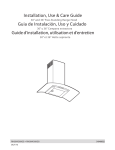



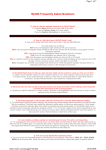

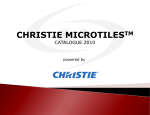
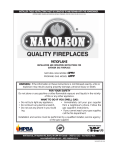
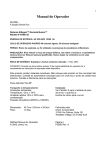

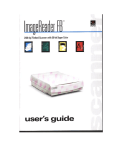



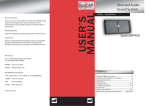
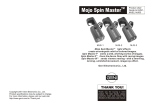

![Model DO402G Dissolved Oxygen Converter [Style: S3]](http://vs1.manualzilla.com/store/data/005725233_1-bd7e4c5bf258da59a958f30153ff00ea-150x150.png)

